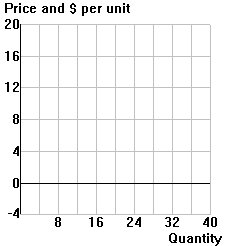| Part 1: The math and geometry of profit maximization |
||||||||||||
| 1. | You are a monopolist with the following demand
and cost information: Q = 40 - 2P TC = 80 + 4Q (note: this cost equation => a natural monopoly) |
|||||||||||
| a. | What is the equation for your inverse demand function? | |||||||||||
| b. | What is the equation for your marginal revenue (MR)? | |||||||||||
| c. | What is the equation for your marginal cost (MC)? | |||||||||||
| d. | Find your profit-maximizing output level (Qm), and calculate each of the following: | |||||||||||
|
||||||||||||
| e. | What is the equation for your ATC? |  |
||||||||||
| f. | Complete the following table of ATC values: | |||||||||||
|
||||||||||||
| g. | In the diagram to the right, plot each of the following: (1) Demand, (2) MR, (3) MC, and (4) ATC. |
|||||||||||
| h. | Shade in your profits at your profit-maximizing output
level.
|
|||||||||||